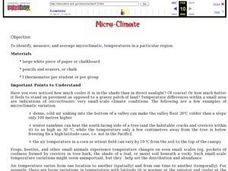Curated OER
Thinking Like a Scientist
Students examine what it is like to be a scientist. In this living environment lesson students complete a group lab activity and answer questions.
Curated OER
Unique Ecosystems
Fourth graders explain how in any particular environment, some kinds of
plants and animals survive well, some survive less well, and some cannot survive at all. They research the ecosystem of which each animal or plant is natively a part.
Curated OER
Biomes of the World (and Canada)
Students explore environments by analyzing food chains. For this biome identification lesson, students define a list of environmental vocabulary terms such as tundra, rain-forest and desert. Students create a fictional self sustainable...
Michigan Sea Grant
Wetlands
Wetlands may not sound particularly ornate, but they are as important as any habitat! With a hands-on activity, young scientists build a wetland model and observe its many functions in action. They discover the importance of wetlands to...
Michigan Sea Grant
Fish Identification
Using a dichotomous key, pupils identify characteristics of fish who live in the Great Lakes and explain how these features help them survive. In small groups, class members discover what features scientists consider important and...
Curated OER
Ocean Habitats
Students examine the water samples from a demonstration and discuss the difference between fresh and salt water. They draw different animals that live near or in the ocean and how humans can harm the ocean habitat. They draw pictures of...
Curated OER
Squirrel Islands
In this adaptations worksheet, young scholars read about 3 species that have changed over time to adapt to their environment. Students design a squirrel that has adapted to an island habitat that young scholars are assigned. They...
Curated OER
T's Alive! Or Is It?
Learners explore data on the bone, muscle, and skin of living systems and then create a list of characteristics of these systems and relate these characteristics to bone, muscle, and skin.
Curated OER
Plants Alive! How Plants Grow and Move
Learners explore how plants move in response to the environment. In this plant lesson plan, students engage in three different experiments to investigate how plants grow and move. Resources available in English and French.
Curated OER
Global Resources: What Will You Do with Your Power?
Learners examine the human impact on natural resources. They read and discuss an article, evaluate nations regarding their environmental problem-solving, develop a presidential speech on the environment, and conduct a natural resources...
Curated OER
Dirty Decomposers
Students explore the ecosystem by conducting a ziploc bag experiment. In this recycling lesson, students identify decomposer organisms in our environment and how they speed up the recycling process. Students utilize a ziploc plastic bag,...
Curated OER
Can Worms See?
Second graders discuss the previously created worm compost and the importance of living creatures to the Environment. In this worm lesson, 2nd graders observe worms and record their sensitivity to light. Students design a petri dish...
Curated OER
Into the Bat Cave
Students explore the lives of bats. In this bat lesson plan, students participate in up 6 activities that focus on bats and build their background knowledge about the nocturnal mammals.
Curated OER
Using Abiotic and Biotic Parameters to Monitor Air Quality
Students identify the abiotic factors that influence a river or stream and the organisms that live in it. They measure several abiotic and biotic parameters to gauge water quality. Students examine the biotic environment by identifying...
Curated OER
Layers of the Forest
Students explore rain forests. In this rain forest ecosystems lesson, students identify and describe the layers of the rain forest. Students paint and decorate a large rain forest mural. Students write riddles about animals that live in...
Curated OER
Toxicology and Living Systems
Learners investigate how toxic chemicals affect biological systems. They determine the toxic dose of a chemical that inhibits seed germination in a Brassica rapa. They investigate the effect of environmental tobacco smoke on human lung...
Curated OER
Throwing It All Away?
Pupils read a New York Times article as part of their investigation as to what happens when an item is thrown away or recycled. They analyze the relationship between a product's ingredients and its effect on the Earth and healthful living.
Curated OER
Where is Away?
Focusing on where are garbage goes once we dispose of it, learners explore environmental concerns. Using a clear format, this lesson leads learners through a discussion of waste reduction, recycling, and composting. Then, they discuss...
WindWise Education
Are Birds Impacted by Small Wind Turbines?
How do we know if the wind turbine at our school is impacting birds? Here, small groups work together and conduct field work in order to determine the impact of a human-made structure on birds. The groups also determine their searcher...
Curated OER
Micro-Climate
Atmosphere aces investigate the microclimates that exist within a larger area. They use a thermometer to record the varying temperatures and identify the microclimates on a map that they have drawn. This exercise helps them to understand...
Curated OER
Adaptations
Cacti have special adaptations for living in desert heat and dryness. Polar bears have adaptations that allow them to withstand icy conditions. Humans adapt to different conditions by wearing appropriate clothing or building homes...
Curated OER
Prairie Senses
Second graders use their senses to explore a prairie or imaginary prairie. They draw pictures to represent the five senses and discover how an artist describes non-visual sensations in a visual way.
Curated OER
How We're Connected
Students take a survey in order to find out how they live in relationship to the environment. They take the time to investigate the differences between a need and a want. This is done as part of the self-assessment. Students also study...
Curated OER
Perched Parrot Decorative Chair
Students discuss the rainforests and why they are important to the Earth's environment. They study the habitats and characteristics of various animals that live in rainforests. Students build a decorative chair using a rainforest theme.

























